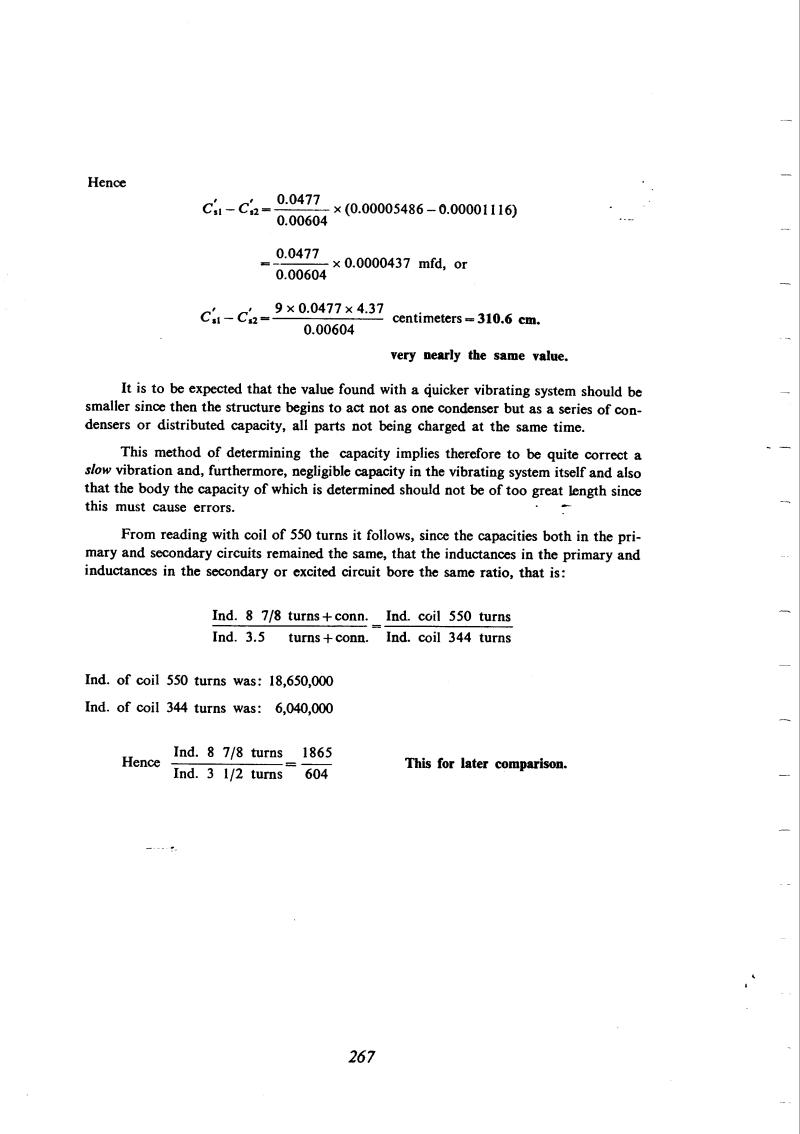
Nikola Tesla Books
Hence
C's1 - C's2 = $! {0.0477 \over 0.00604} $! x (0.00005486 - 0.00001116)
= $! {0.0477 \over 0.00604} $! x 0.0000437 mfd, or
C's1 - C's2 = $! {{9 \times 0.0477 \times 4.37} \over 0.00604} $! centimeters = 310.6 cm.
very nearly the same value.
It is to be expected that the value found with a quicker vibrating system should be smaller since then the structure begins to act not as one condenser but as a series of condensers or distributed capacity, all parts not being charged at the same time.
This method of determining the capacity implies therefore to be quite correct a slow vibration and, furthermore, negligible capacity in the vibrating system itself and also that the body the capacity of which is determined should not be of too great length since this must cause errors.
From reading with coil of 550 turns it follows, since the capacities both in the primary and secondary circuits remained the same, that the inductances in the primary and inductances in the secondary or excited circuit bore the same ratio, that is:
$! {\text{Ind. 8 7/8 turns+ conn.} \over \text{Ind. 3.5 turns + conn.}} $! = $! {\text{Ind. coil 550 turns} \over \text{Ind. coil 344 turns}} $!
Ind. of coil 550 turns was: 18,650,000
Ind. of coil 344 turns was: 6,040,000
Hence $! {\text{Ind. 8 7/8 turns} \over \text{Ind. 3 1/2 turns}} $! = $! {1865 \over 604} $!
This for later comparison.
267
November 7
Measurement of the capacity of the structure at two frequencies was intended to demonstrate the reduction of effective capacity with increasing frequency. Tesla did in fact obtain a small difference, but it is dubious proof considering the accuracy of the measurements. The frequency difference was quite large, from 50 kHz to nearly 250 kHz (using âextraâ and âexperimentalâ coils).
November 7
He measures the structure capacitance with two coils, one is a new "additional coil" (please see Oct. 31). The results are similar to those of Nov. 6. An attempt to measure the structure capacitance at two frequencies was intended to prove that the capacitance is reduced when the frequency is increased. Tesla obtained a small difference but without that it is a reliable proof when we take in account the measurement accuracy. Otherwise the frequency changed substantially; from approximately 50 Hz to almost 250 KHz{during the period of obtaining the measured results with the "additional" and "experimental" coil).

